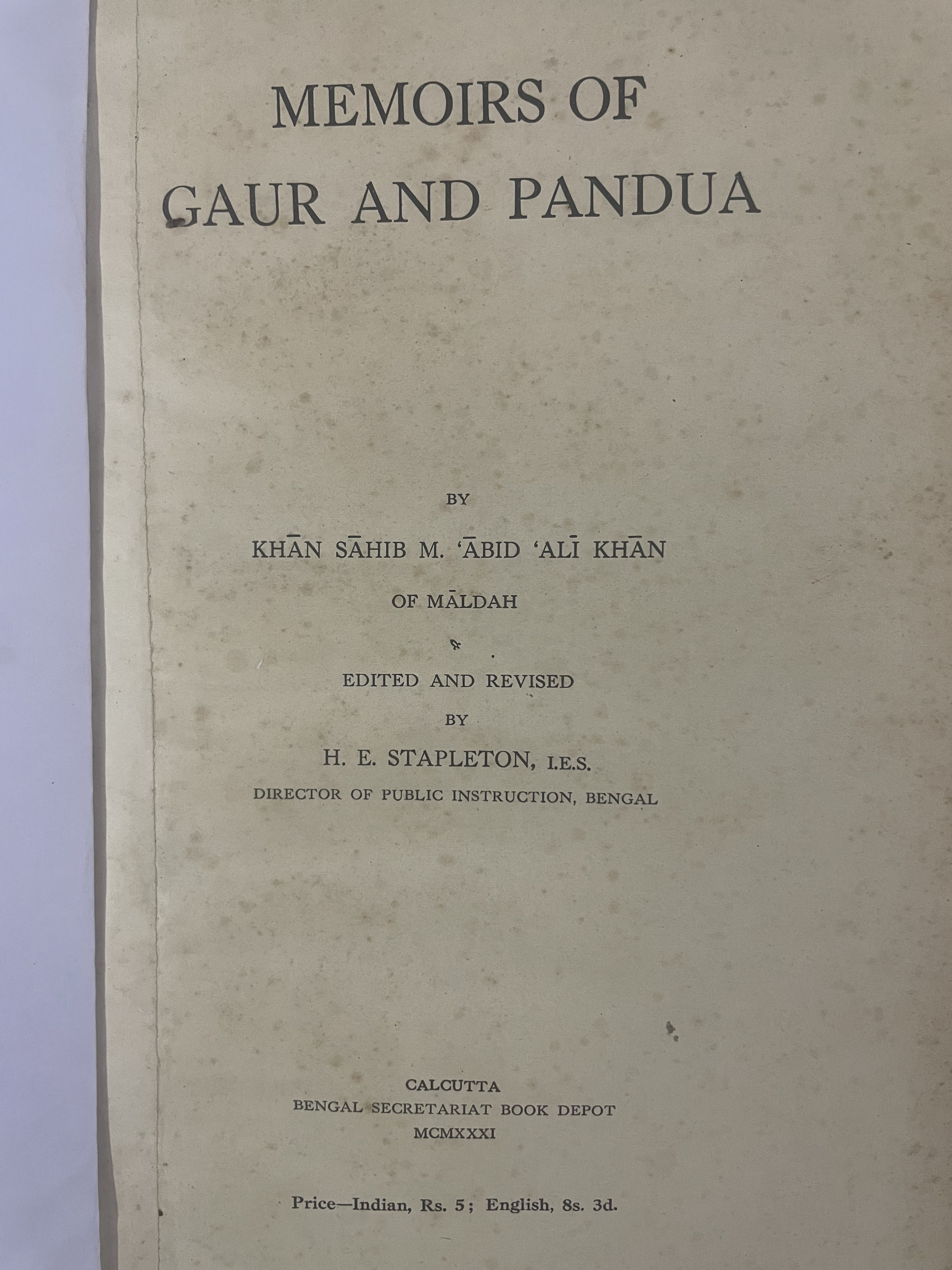Memoires of Gaur and Pandua

About
Summary
Exquisite
TOC
Details
Related
URL
Images
Overview
Memoirs of Gaur and Pandua, authored by Khan Sahib M. Abid Ali Khan and edited and revised by H. E. Stapleton, Director of Public Instruction, Bengal, is a historical account of the two capital cities of medieval Bengal. Published in 1931 by the Bengal Secretariat Book Depot, Calcutta, the book delves into the antiquities, history, and notable figures associated with Gaur and Pandua. It includes historical accounts of the monuments of Delhi. The book also has photographs and illustrations.The book provides a detailed description of the cities of Gaur and Pandua, which served as capitals of Bengal during its medieval period. Gaur and Pandua are located in West Bengal, India1. Khan Sahib M. Abid Ali Khan, drawing upon historical sources and local knowledge, reconstructs the history of these cities, focusing on their architectural heritage and the political events that shaped their destinies. The book covers a long period of history and discusses important viceroys and kings of Gaur and Pandua.
Importance of Book
Historical Documentation: Memoirs of Gaur and Pandua serves as a valuable historical document, preserving information about the history, architecture, and culture of these important cities.
Archaeological Significance: The book contributes to the archaeological understanding of the region, providing detailed descriptions and illustrations of the monuments and antiquities.
Preservation of Cultural Heritage: By documenting the cultural heritage of Gaur and Pandua, the book helps to raise awareness about the importance of preserving these historical sites for future generations.
Key Themes
Historical Account: The book provides a comprehensive historical account of Gaur and Pandua, tracing their origins, rise to prominence, and eventual decline.
Architectural Survey: It offers a detailed survey of the architectural landscape of these cities, describing the various monuments and their unique features.
Cultural Synthesis: The book highlights the cultural synthesis that occurred in Gaur and Pandua, where indigenous Bengali traditions blended with Islamic influences to create a distinctive architectural and cultural identity.
Cultural Significance
Gaur and Pandua hold significant cultural importance as centers of political power, religious activity, and artistic expression during the medieval period of Bengal. They reflect the region's rich history and its interaction with diverse cultural influences. The monuments and antiquities found in these cities bear testimony to the artistic skills and architectural ingenuity of the people who lived there.
Effects on Society
Historical Awareness: Disseminating knowledge about the history of Gaur and Pandua enhances historical awareness among the people of Bengal and beyond.
Tourism Promotion: By showcasing the architectural and cultural attractions of these cities, the book can help to promote tourism and generate economic opportunities for local communities.
Cultural Preservation: Encouraging the preservation and conservation of historical sites and monuments helps to protect the cultural heritage of the region for future generations.
Conclusion
Memoirs of Gaur and Pandua by Khan Sahib M. Abid Ali Khan is a valuable resource for understanding the history, architecture, and culture of these important cities in Bengal. The book helps to preserve the memory of a region that was rich in political power, religious diversity, and artistic brilliance.
Table of Content
\"Memoirs of Gaur and Pandua\" by Khan Sahib M. Abid Ali Khan, published in 1931, is a historical work focusing on the cities of Gaur and Pandua, which were significant centers during the medieval period in India. The book provides insights into the history, architecture, and cultural heritage of these cities.Here is a typical table of contents for the 1931 edition of \"Memoirs of Gaur and Pandua\":PrefaceIntroduction to the book, outlining its purpose and scope, and providing context for the historical narrative.
Chapter 1: Historical Background of GaurDetailed account of the historical significance of Gaur, including its rise as a major city and its role in the region\'s history.
Chapter 2: Architectural Heritage of GaurDescription of the architectural landmarks and monuments in Gaur, including detailed analysis of their design, construction, and historical importance.
Chapter 3: Cultural and Social Life in GaurExploration of the cultural and social aspects of life in Gaur during its peak, including customs, traditions, and notable figures.
Chapter 4: The Rise and Fall of PanduaHistorical narrative covering the development of Pandua, its significance as a cultural and political center, and its eventual decline.
Chapter 5: Architectural Monuments of PanduaExamination of the key architectural sites in Pandua, detailing their historical context and architectural features.
Chapter 6: Daily Life and Administration in PanduaInsight into the administrative structure and daily life in Pandua, including governance, economy, and social organization.
Chapter 7: Comparative Analysis of Gaur and PanduaComparative study of the two cities, highlighting their similarities and differences in terms of historical development, architecture, and cultural significance.
Chapter 8: The Legacy of Gaur and PanduaDiscussion of the lasting impact of these cities on the region\'s history and their role in the cultural heritage of India.
ConclusionSummary of the key points covered in the book and reflections on the historical importance of Gaur and Pandua.
Title
Memoires of Gaur and Pandua
Author
Khan Sahib M Abid Ali Khan
Name of Publisher
Bengal Secretariat book Depot
Publish Date
1931
Subject
A historical work focusing on the cities of Gaur and Pandua
Vintage
1901-1947
Category
Literary
Sub Category
History
Rarity
RARE
